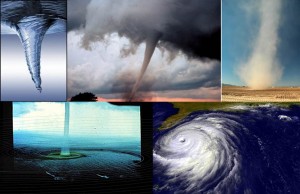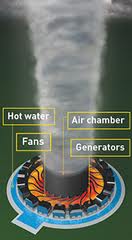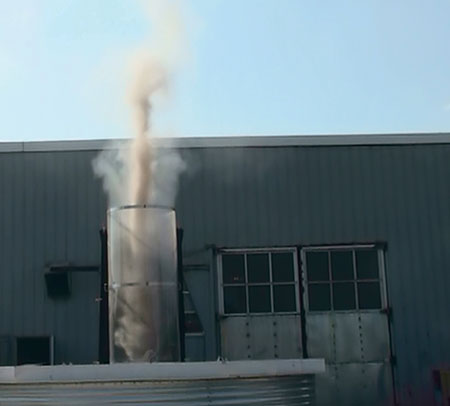Sometimes you come across a technology concept that just sounds like a bad idea. I’m not sure if this one is or isn’t but but a proof-of-concept is getting funded by a well known serial entrepreneur.
The idea is to harness the wind energy derived from vortices. Nature is full of them. They come as hurricanes, tornadoes, waterspouts, and whirlpools. We witness them when we empty our sinks watching the water swirl above the drain. And one Canadian engineer has been experimenting to turn the force created from whirling wind or water into a form of renewable energy.

The company is Avetec. It’s located in Sarnia, Ontario and its founder, Louis Michaud, an electrical engineer, is developing what he has branded the Atmospheric Vortex Engine (AVE), literally a tornado in a bottle with the top uncorked.In more conventional terms AVE is a potential energy pressure difference machine that extracts energy from the pressure differences that accompany a vortex.
AVE creates a vortex by introducing warm, humid air into the base of a circular chamber using tangential airflow. The air circulates and begins to rise. Initial energy input can come from almost any heat source. AVE sits at the base of a cooling tower and captures the energy from the swirling air using axial flow turbines. As heated air is continuously fed into the tower it forms a vortex. The energy from the spin then drives the turbines. The vortex is controlled by adjustable deflectors placed inside the tower. And Michaud states that a vortex can be stopped at any time simply by restricting the source of heat.
AVE can be added to almost any existing heat-generating source. The heat can can come from a natural process like a geothermal spring, or warm tropical ocean water,or from industrial processes such as waste industrial heat coming from a factory, or the excess generated by thermal power stations burning coal, natural gas or oil. Even a solar generator can be a source of the heating mechanism to drive an AVE.
Why a vortex rather than conventional wind turbines? Because the kinetic energy contained within a vortex is much greater than that in horizontal wind.
So what does the AVE look like?
- A circular tower with a diameter ranging between 50 and 200 meters (164 to 656 feet)
- A tower height of 30 to 80 meters (98 to 262 feet)
- Vortex base diameter between 20 and 100 meters (65 to 328 feet)
- Vortex height would exceed the tower height rising from 1 to 20 kilometers (3280 feet to 12 miles)
How would it work?
The cylindrical wall would channel the air which would then move in circular fashion to establish a continuous vortex. As more heat and humid air was fed into the chimney the air would rotate and rise, retaining its angular momentum. The air column would escape from the top of the tower eventually reaching the tropopause. Momentum could be continuously maintained creating a permanent vortex or cycled to produce temporary vortices.

Sounds like science fiction but it may soon become science fact. PayPal’s co-founder, Peter Theiss, through Breakout Labs, has invested $300,000 to develop a proof-of-concept demonstration unit. An AVE with a diameter of 100 meters (328 feet) could harvest 200 Megawatts of power. The proof-of-concept will be 30 meters (98 feet) tall and 8 meters (26 feet) in diameter.
Michaud believes that AVE can use the heat outflow from existing power generating technologies such as coal and natural gas-fired as well as solar heat power plants piggybacking on them to harvest additional energy from what would normally be vented into the atmosphere. In an article that appeared in the April 2011 edition of Mechanical Engineering he states that “ejecting 1,000 MW of waste heat from a 1,500 MW thermal plant to the upper atmosphere instead of doing it at ground level can generate an additional 200 MW of electrical energy.”

Why consider this as a renewable energy solution? Michaud argues that creating a human-induced controllable tornado produces no damaging emissions while harvesting the incredible amounts of energy inherent in these types of storms.
So why haven’t we developed this type of technology before? One reason is the fear that a human-induced vortex could spawn tornadoes if the vortex escaped from the tower. It should be noted that unlike real tornadoes which are caused by sudden downdrafts associated with thunderstorms, AVE produces a confined vortex that is an updraft. But what if a thunderstorm forms near an operational AVE? Couldn’t that kickstart a tornado? Not likely because the AVE can be shut down rapidly by removing the heat source and adjusting the angle of the deflectors.
So would an AVE pose a safety hazard? Probably not. The proof-of-concept should answer most of these questions.









((One reason is the fear that a human-induced vortex could spawn tornadoes if the vortex escaped from the tower))
A much greater “fear” is that the capital costs of the apparatus will exceed the value of energy harnessed. The fundamental physical problem is the energy source is low-grade heat. The problem is akin to that of wind turbines. The amount of energy a given wind turbine can harness is fixed at a cube function of wind speed. My guess is that a rigorous mathematical analysis of the physical elements involved in creating the artificial vortex would transform the “fear” of economic loss into a “certainty.”
This is not a new idea. I looked into this and similar concepts back in the 60s. One should keep in mind that regions of atmospheric dynamics that are miles across, involving millions of tons of moving mass, produce natural tornados. To create an “artificial” tornado that produces comparable high wind speeds, will require either higher initial differential temperatures or huge artificial structures. Should work at least as well as Cogar International’s Hydro-Electric generator.
Can you list pros and cons about the atmospheric vortex engine benefiting/not benefiting us as a society.
The benefits of a controlled and contained vortex are obvious if the energy input to get them started is less than the output received. This should be in geometric proportion and comparable to the best performance of other energy sources. The downside of controlled vortices is the potential unknowns. Can we start a vortex and watch it become uncontrolled, in other words, create a tornado that causes damage? Since all prototypes so far are not on an industrial scale it is pretty difficult to determine if the worst case scenario could occur.
(apologies for replying to the thread with this, but I can’t find your email address! Please delete this message once actioned)
Hi there,
My name is Paul Groom, I’m a photographer from the UK and I noticed you’ve used my image of a vortex (shown here: http://paulgroomphotography.co.uk/107/ ) without asking permission!
Oh dear! Never fear, though! If you would like to carry on using this image then it is essential that you link to my site from your webpage with a credit. Please add on the page on which the image is being used (which is the Vortex Brewer page):
Vortex image by Paul Groom Photography – Bristol Photographer, UK.
If you could make the words Bristol Photographer link to my website:
http://www.paulgroomphotography.co.uk
… and simply let me know when it’s done!
Thanks
Paul
The image of the vortex is credited to you in the composite photograph.
Aha, I see that now! Could you make it an actual link on the page?
Thanks for your speedy response.
Done!
Absolutely wonderful! Thanks so much, and have a lovely weekend.
Paul
[…] up tiny vortexes and scaled up versions of these would enable creation of bigger tornadoes! {https://www.21stcentech.com/energy-update-artificial-tornado-to-generate-electricity/} 4. Parvatastra – Would cause a Parvata/mountain to fall on the target from the skies which […]